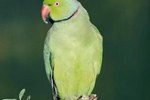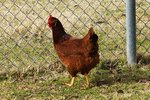
Guinea fowl -- both sexes are often called French Guinea hens -- are easy to feed. Their natural diet consists of mainly high protein seeds and insects and they will find most of their own food if they have a large area to forage in. This can be supplemented with a regular poultry mash.
Supplementary Feed for Adult Guineas
Guinea fowl will need supplementary feed in the winter and can be fed chicken layers mash. This is commercial formulated feed, and provides everything birds need for life in a carefully controlled mixture of proteins, fats, calcium, vitamins and trace elements. While produced for chickens, guineas do fine on it. Also provide a little mash in the summer, in a regular place, to help keep the birds close to home. Guineas love wheat, milo and millet, but only give them whole or cracked grains, and as a treat. These favorite foods are too high in fat, and too low in protein to have any real nutritional value. As guineas prefer roosting in trees, millet seed makes a good bribe when trying to get them inside at night. Clean water should be available for drinking.
Feeding Keets
Guinea fowl chicks are called keets. For the first five weeks, give them a nonmedicated turkey or game bird starter feed with 24 to 26 percent protein. From 5 to 8 weeks of age, change to a feed with 18 to 20 percent protein. After that feed regular layers of mash. If feed with different amounts of protein isn't available, mix layers of mash with the high protein food when the young birds get to 5 weeks old. Keets need warm drinking water as they don't cope well with cold water.
References
- Raise Happy Chickens and Other Poultry; Victoria Roberts
- University of Connecticut Cooperative Extension System: Guinea Fowl Management
- The University Of Maine Cooperative Extension: Livestock: Poultry - Guinea Fowl May Be the Solution to Insect Pest Problems
- Choosing and Keeping Chickens; Chris Graham
Photo Credits
-
Hemera Technologies/Photos.com/Getty Images



